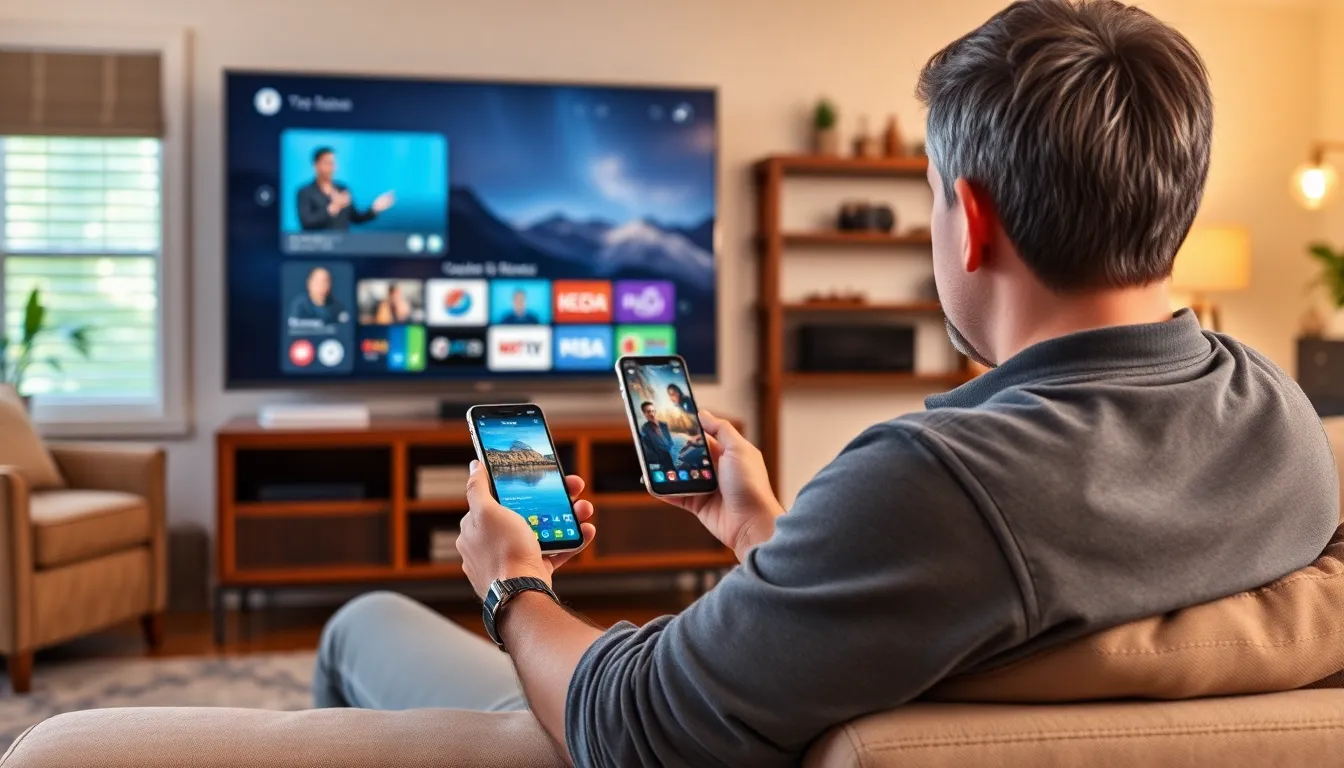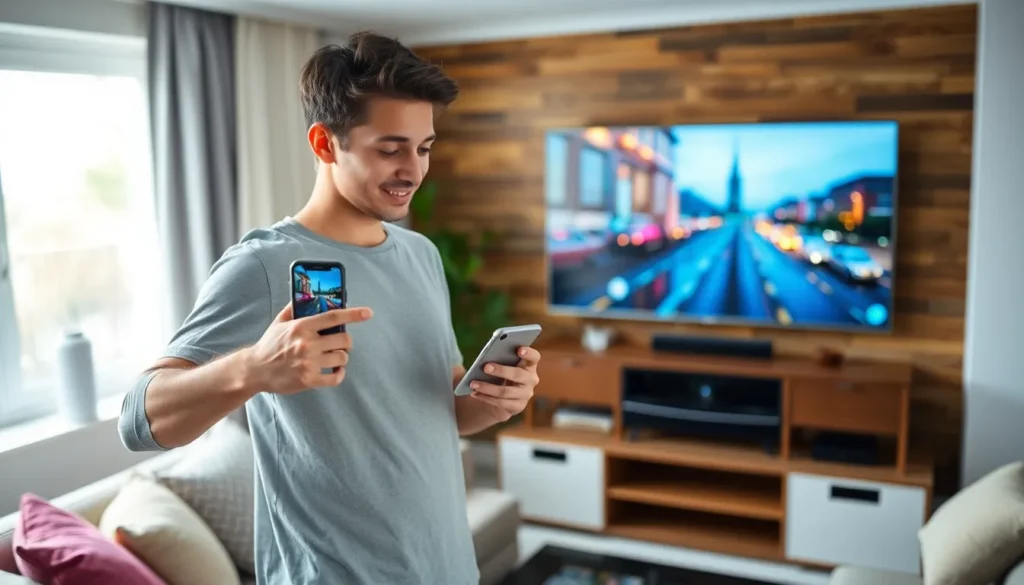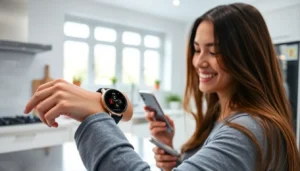Table of Contents
ToggleEver found yourself wishing you could share that hilarious cat video with friends on a bigger screen? Or maybe you want to show off your latest vacation snaps without squinting at your iPhone? Screen mirroring on an iPhone is the magic trick you didn’t know you needed. It’s like having a personal projector right in your pocket, ready to dazzle your audience at a moment’s notice.
What Is Screen Mirroring?
Screen mirroring allows users to display their iPhone screens on a larger device, such as a smart TV or projector. This functionality enables seamless sharing of photos, videos, and apps, enhancing visual experiences for everyone involved.
Users can easily show their favorite media to friends and family. With quick setup steps, individuals connect their iPhones to compatible devices. Utilizing Wi-Fi or Bluetooth makes the process straightforward and efficient.
Supported devices feature AirPlay technology, Apple’s proprietary streaming protocol. This technology allows smooth transmission of audio and video from the iPhone to the larger screen. As a result, users enjoy an immersive experience while sharing content.
Various applications benefit from screen mirroring, including presentations, gaming, and video streaming. It provides an opportunity to engage an audience more dynamically. Educational settings often utilize this feature for interactive learning sessions.
Screen mirroring requires both the iPhone and target device to be on the same network. Once connected, control over what appears on the screen remains with the iPhone user. This level of control enhances the sharing experience and allows for interactive participation.
Overall, screen mirroring serves as a powerful tool for effective communication and entertainment. Users can easily leverage this feature in different scenarios, making it a practical addition to their digital toolkit.
How to Prepare Your iPhone for Screen Mirroring

Preparing an iPhone for screen mirroring involves a few essential steps. Users must ensure their devices are compatible for a smooth experience.
Check for Compatibility
Supported devices include smart TVs, Apple TVs, and various streaming devices that support AirPlay. Apple’s website provides a list of compatible devices to ensure seamless connection. Older models of iPhones may not mirror effectively with newer technology. It’s important to confirm that both the iPhone’s iOS version and the target device’s firmware are up to date. Preference lies with devices designed for AirPlay to maximize video and audio quality during mirroring.
Connect to the Same Wi-Fi Network
Connecting both the iPhone and the target device to the same Wi-Fi network is crucial for successful screen mirroring. Users should navigate to their phone’s Wi-Fi settings to verify the network connection. Having both devices on the same network eliminates potential connectivity issues. Use the home Wi-Fi for optimal performance, as public networks may result in interruptions. Make sure to check that the Wi-Fi network is stable for a smooth streaming experience.
Steps to Screen Mirror on an iPhone
Screen mirroring on an iPhone is simple and efficient. Users can follow these steps to share their content seamlessly.
Using AirPlay
First, users should ensure their iPhone and target device, like an Apple TV or AirPlay-compatible smart TV, are connected to the same Wi-Fi network. Accessing the Control Center on the iPhone enables quick toggling for screen mirroring. Users swipe down from the upper-right corner of the screen for iPhones with Face ID or swipe up from the bottom edge for earlier models. Tapping the “Screen Mirroring” icon displays available devices. Selecting the desired device establishes the connection. Once a connection occurs, users see their iPhone screen mirrored on the larger display instantly.
Using Third-Party Apps
Some users may prefer third-party apps for additional features. Applications such as Reflector, ApowerMirror, or LetsView provide alternative options for screen mirroring. First, users need to download and install the chosen app on both their iPhone and target device. Open the app on both devices to ensure connectivity. Next, users follow specific instructions provided by the app for a smooth setup process, usually involving selecting the target device within the application interface. These apps often support additional functionalities, enhancing the overall screen mirroring experience with features like remote control and advanced settings.
Troubleshooting Screen Mirroring Issues
Screen mirroring can occasionally present challenges. Identifying and addressing problems quickly improves the overall experience.
Common Problems and Solutions
Connectivity issues often arise when the iPhone or target device is not on the same Wi-Fi network. Ensuring both devices are connected to the same network resolves this typically simple issue. Users might also encounter lag or disconnection during mirroring. Restarting both devices can restore connection integrity and enhance performance.
Incompatibility can result from outdated software, hindering proper functionality. Updating the iPhone’s iOS and the target device’s firmware eliminates many bugs and connectivity challenges. Sometimes, adjustments to firewall or security settings may be necessary. Configuring these settings allows seamless communication between devices.
Unexpected black screens can occur when mirroring. Users should toggle the screen mirroring mode off and then back on to refresh the connection. Monitoring proximity to the router helps maintain a stronger signal, reducing interruptions. Checking for interference from other wireless devices may also enhance performance.
Screen mirroring on an iPhone opens up a world of possibilities for sharing and enjoying content. Whether it’s showcasing photos during a family gathering or delivering an engaging presentation in a classroom, the feature enhances the viewing experience.
By following the simple setup steps and ensuring both devices are on the same network, users can easily connect their iPhones to smart TVs or projectors. Troubleshooting common issues can further streamline the experience, making it accessible for everyone.
With its ability to transform any space into an interactive media hub, screen mirroring is an essential tool for both personal and professional use. Embracing this technology can elevate how users share and enjoy their digital content.




